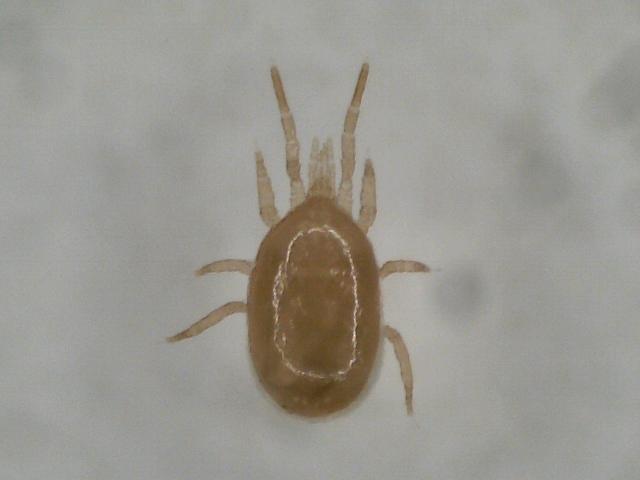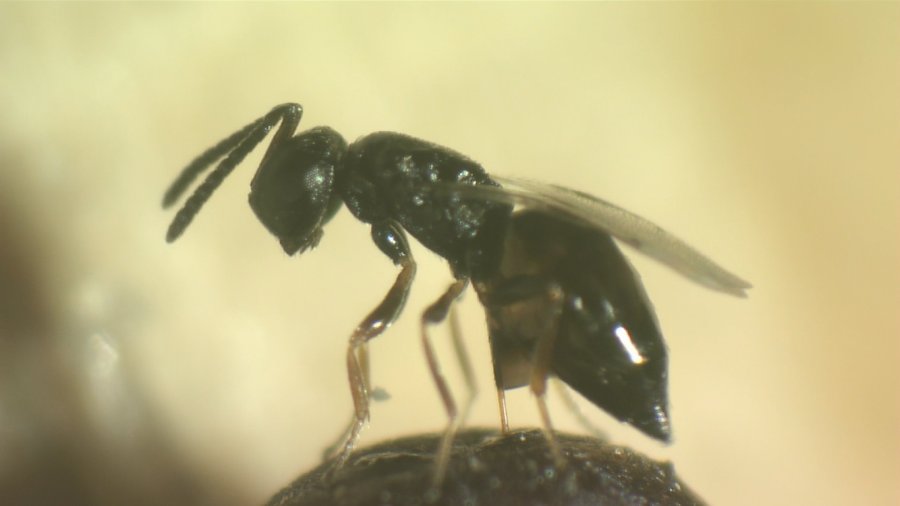
A growing number of egg producers have turned to parasitic wasps and predatory mites to achieve control of fly and red mite populations.
Keeping a lid on fly and red mite numbers is a constant battle for egg producers, particularly as the weather warms up.
Over the summer months, the lifecycle of red mite speeds up to just 7-8 days making them harder to control, particularly as they only emerge at night.
This means that the first sign of an infestation is often anaemic birds or blood spotted eggs.
Red mite can take a significant toll on a flock by causing restlessness and lack of sleep in the birds, as well as being vectors of disease.
They are also an economic drain on farmers as the mites can cause a drop in egg production and quality, resulting in an annual economic cost as great as £1 per hen.
Producers have long been reliant on chemical acaracide products to maintain control within their housing.
However, many products have been withdrawn due to consumer safety standards and those that remain available are suffering from ever increasing red mite resistance.
This has led to increasing attention being paid to non-chemical based treatments.
Predatory mites
APPI Biotech are part of the Koppert group, who are a world leader in biological pest control for the horticultural sector.
For livestock farmers they produce a range of natural solutions based on beneficial insects protecting their animals from pests.
They commercially rear two species of predatory mite, Androlis and Taurrus, which are released into housing to tackle and prevent red mite infestation.
Jeroen Koppert, founder and director of APPI, said: “Both species of predatory mite are indigenous to the UK and commonly found in wild bird nests.
They are completely safe for birds, humans, and the environment and they can reach the inaccessible hiding places that may be missed by chemicals and humans.
"Unlike chemicals, there is no chance of resistance, greatly improving the health of your birds”.
The Androlis and Taurrus mites work very effectively together by targeting different stages of the red mite cycle.
Androlis primarily feed on red mite that are in their juvenile stages and is a highly mobile predator, whilst the Taurrus is more voracious and preys on all stages but is slower to disperse.
Jeroen explained that it is quite straightforward to apply the predatory mites: “There are several methods that can be used.
"Depending on your order, you will receive tubs of Androlis and Taurrus at a mixture of life stages, which you can scatter on the floor, nest boxes, and slats.
"You may also receive large bottles of the predatory mites that are placed into a fixed position for slow release”.
He continued: “The predatory mites will then seek out the red mite and consume them. The populations of the predatory mite will grow as they feed on the red mite, but when red mite numbers are low, their numbers will also drop, as there is not enough prey to sustain them.
"As red mite populations pick back up in the warmer months, more predatory mites will need to be added to keep on top of the red mite population.
"Year after year the red mite populations will become easier to control”.
MiteControl
Researchers at ADAS are currently working as a project partner on the MiteControl project, which is investigating novel methods of controlling red mite in commercial laying systems.
Jon Walton from ADAS said that they were trialling predatory mites as part of this.
“We now have three farms in the UK trialling both the Androlis and Taurrus species, alongside a water additive, as part of a trial into an integrated pest management (IPM) approach.
"The principle of an IPM approach is to use a combination of non-chemical methods to keep red mite populations at an acceptable level,” he said.
Jon explained that whilst trials were still ongoing, they had been able to observe the impact of the predatory mites.
“One of the farms has just been depopulated and has shown positive results," he added.
"We had a control site where we used a chemical to control red mite, whilst in the trial house we used only predatory mites and the water additive.
“The trial started in May last year, when we saw some very warm temperatures, and we measured the red mite levels in both houses using traps.
"We saw an initial peak in red mite numbers in the trial house that was much higher than in the control house.
"However the numbers slowly came down, and by the end we were finding that we had better control using the predatory mites in the trial house.”
Jon continued: “You are not necessarily going to get immediate impacts with predator mites, it takes them a while to establish themselves.
"Like any predator-prey relationship, there will be a growth in the prey population which is followed by a growth in the predator population.”
Fly control
Flies can be another big issue for egg producers over the summer months, as they irritate hens and spread disease, meaning it is important to act early.
With chemical controls proving to be both expensive and an environmental risk, APPI provide an alternative - parasitic wasps.
The parasitic mini-wasps are a natural predator of the fly and are morphologically different to the typical wasp you may imagine, being little bigger than a pinhead and inconspicuous to animals and humans.
Jeroen Koppert explained how they work: “The mini-wasps are introduced at fortnightly or monthly intervals into areas where flies like to breed – typically around muck, feeding areas, and drinkers.

They work by injecting their own eggs into pest fly pupae which then gain nourishment by consuming the contents and hatching into new mini-wasps, rather than pest flies”.
He also said that it is important to get on top of a fly population before it becomes problematic.
“We generally recommend starting a fly control programme early in the season, typically early-mid spring, so that a population of mini-wasps can be established in order to address the juvenile stages of pest flies before adults become a problem."
APPI currently have customers using the mini-wasps on both organic and non-organic sites.
“We generally do not recommend using chemicals in conjunction with the mini-wasps and care should be taken to ensure they are not introduced to an environment containing residual chemicals from previous treatments.
"Resistance is, of course, not possible with our biological methods because the mechanism is physical, not chemical," he said.
On the farm
Nick McTurk runs a 16,000 bird flat deck system in Essex and has been using both the predatory mites and the parasitic wasps supplied by APPI.
“We have been in eggs for 12 years now, and we started off doing our fly and red mite control with conventional chemical based products," he said.
"We were getting fairly good control, but we were having to take a lot of precautions to avoid residues and I found it was very difficult to avoid getting any of the chemical on myself when I was applying it with a knapsack sprayer.”
This meant that Nick was on the lookout for an alternative solution, and when he came across APPI’s biological pest control solutions at the Pig and Poultry Fair he thought they were worth trying.
Nick initially decided to trial the predatory mites: “We used the predator mites in just one house to start with and we got the same level of control as in the other houses where we continued to use chemical products.
"Since then, we have carried out all of our red mite control using the predatory mites and we are finding that there is a cumulative effect over flocks, with control improving year to year,” he said.
“With conventional chemical control, you are always working on the back foot and when the population gets too great you go and hit it, whereas with biological control it is easier to gain control of the population before it grows too big.”
Nick explained how his control usually works over the course of a flock: “In a normal year, if we had put a flock in during December, we would put our first dose of mites down in April or May when the weather warms up.
"Then every six weeks or so we would put another dose in until the autumn when we would reduce the applications.
"This year we have had to do a few more applications because with the birds being housed the temperature in the sheds has stayed relatively high.”
More recently Nick has started using the parasitic mini-wasps for fly control: “We put a dose in during the spring at the same time as the mites, and then one more dose during the summer.
"We have got on very well with them and we have not had any problems with flies at all since we started using them.”
He added: “They arrive in little tubes, about eight inches long, full of sawdust and pupae which I just scatter about as evenly as I can across the slatted area, whilst I also spread two tubes on the muckheap”.
“I have now almost completely eliminated chemicals from my sheds, meaning I have no residues or any of the other challenges that come hand in hand with chemical storage and use, whilst maintaining a good level of control over fly populations.”
